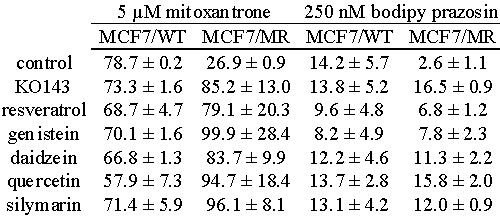| pA2 online © Copyright 2004 The British Pharmacological Society |
115P
GKT, University of London Winter Meeting December 2003 |
|
Interaction
of breast cancer resistance protein (BCRP/ABCG2) with flavonoids |
|
Multidrug resistance is often associated with reduced intracellular drug accumulation due to overexpression of one or more ATP-binding cassette multidrug transporters: P-glycoprotein, the multidrug resistance associated proteins (MRPs) or the recently discovered half-transporter, Breast Cancer Resistance Protein (BCRP) (Allen et al., 2002). Flavonoids are plant-derived, low molecular weight polyphenolic compounds, some of which have potent antioxidant, anti-proliferative, anti-carcinogenic and anti-thrombotic effects and have been shown to inhibit P-gp and MRP1 (Leslie et al., 2001).
We here demonstrate that certain flavonoids are able to modu-late the accumulation of established BCRP substrates in cells of the BCRP-overexpressing carcinoma cell line MCF7/MR but not in the wild-type cell line, MCF7/WT (cells kindly donated by G. Scheffer of Free University, Netherlands). The 40-min accumulation of mitoxantrone (5 µM) and bodipy prazosin (250 nM) was monitored using flow-cytometry in the absence or presence of a range of flavonoids, each at 30 µM. The inhibitory effects of these flavonoids (see Table 1) were comparable to that of 10 µM KO143, an established BCRP-specific inhibitor (Allen et al., 2002). We also report that the flavonoids, resveratrol, silymarin and quercetin increase the BCRP-associated ATP-ase activity in membrane vesicles derived from BCRP-overexpressing Lactococcus lactis bacteria (maximal stimulation 2.4, 3.3 and 3-fold) with concentrations for half-maximal stimulation (SC50) of 24±6, 6.3±0.2 and 3.8±0.9 µM respectively (duplicate determinations in two vesicle preparations) (Janvilisri et al., 2003). No comparable increases were evident in vesicles of the vector-transformed control cells (Janvilisri et al., 2003).
Table 1. Median cell fluorescence in wild-type and resistant cells with substrate alone (control) or with substrate and flavonoid or KO143. The flavonoids alone did not contribute appreciably to the median fluorescence. The probabilities that the variance of values reported in each column would be at least as large on the null hypothesis that treated cells are the same as controls are 0.2193 (mitoxantrone) and 0.0558 (bodipy prazosin) for the wild type cells and 0.0115 and 0.004 for the resistant cells. Dunnet's posthoc test for the resistant cells showed all treatments differed from control (p<0.05).

Taken together these data support the idea that flavonoids can interact with BCRP and so influence its activity.
Allen, J. D. et al.,
(2002) Mol. Cancer. Ther. 1:427-34.
Janvilisri, T. et al., (2003) J. Biol. Chem. 278:20645-51.
Leslie, E. M. et al., (2001) Mol. Pharmacol. 59:1171-80.